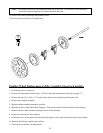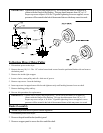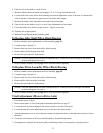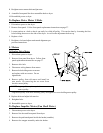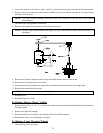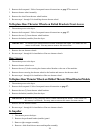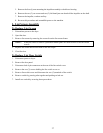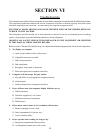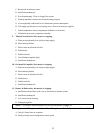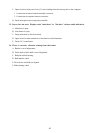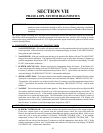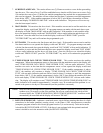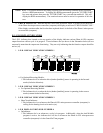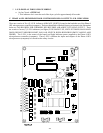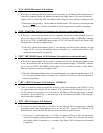
38
SECTION VI
The information provided will help isolate the most probable components associated with the difficulty described.
The experienced technician realizes that a loose connection or broken or shorted wire may be at fault where
electrical components are concerned -- not necessarily the suspected component itself.
ELECTRICAL PARTS SHOULD ALWAYS BE CHECKED FOR FAILURE BEFORE BEING RE-
TURNED TO THE FACTORY.
The information provided should not be misconstrued as a device for use by an untrained person in making
repairs. Only properly licensed technicians should service the equipment
.
OBSERVE ALL SAFETY PRECAUTIONS DISPLAYED ON THE EQUIPMENT OR SPECIFIED
IN THIS MANUAL WHILE MAKING REPAIRS.
Refer to section "Electrical Troubleshooting" for a detailed troubleshooting procedure for electrical components.
1. No display on computer.
A. Open circuit breaker switch or blown fuse.
B. Tripped blower motor overload.
C. Bad wiring connection.
D. Bad transformer.
E. Emergency stop button is depressed.
F. Faulty microprocessor (computer controller).
2. Computer will not accept key pad entries.
A. Key pad ribbon is not plugged into computer securely.
B. Faulty keypad.
C. Faulty microprocessor (computer controller).
3. Dryer will not start, but computer display indictors are on.
A. Failed contactors.
B. Failed arc suppressor (A.S.) board
C. Failed microprocessor (computer).
D. Failed motors.
4. Drive motor runs, burner is on, but basket will not turn.
A. Broken, damaged or loose v-belt.
B. Belts contaminated (oil, grease, etc.).
C. Loose or broken pulley.
5. Dryer operates but is taking too long to dry.
A. Improperly programmed microprocessor.
B. An inadequate exhaust duct work system.
Troubleshooting



